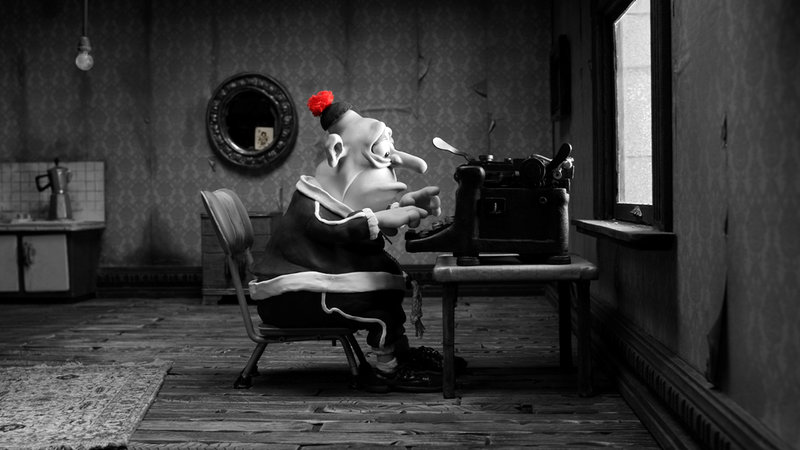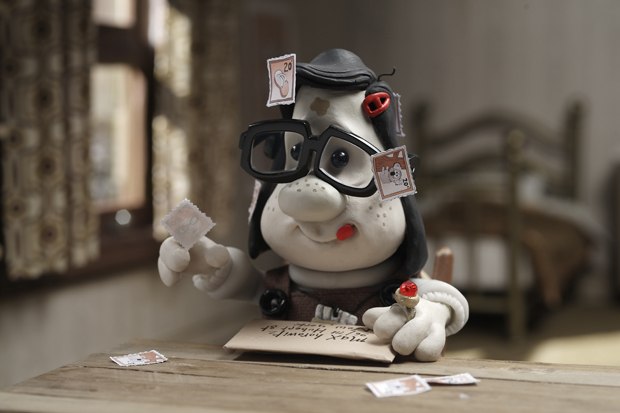Australia: Mary and Max [film review]
Mary and Max is an Australian film directed by Adam Elliot in 2009. It follows two separate stories of Mary, an 8 year old girl who is lonely in Australia and Max, a middle aged man with Asperger's syndrome, who is lonely in New York. They become pen pals, and over the course of about 20 years become friends.
The core themes of the film include loneliness, neglect, friendship, depression, suicide, anxiety, disability, alcoholism, bullying, obesity and isolation. These themes are all very challenging things to discuss within a film, but through the use of animation they are able to be talked about openly. Both Mary and Max have feelings of loneliness and isolation at the beginning of the film. Mary's mother is an alcoholic and Mary's father neglects her and so she feels very alone. Max also struggles with obesity, telling Mary that he goes to 'over-eaters anonymous'. Both Mary and Max also experienced bullying. During the film it becomes clear that Max has Asperger's syndrome which causes him to feel depressed and anxious. Towards the end of the film Mary is depressed and also suicidal due to what has happened in her life. But the key theme that brings Mary and Max together is friendship, and how they come to lean on each other through there letters, even though they ever meet in person.
Discussing these challenging themes in an animation allows them to be discussed openly but at a safe distance from the real world. If the film was live action, people may find the film too hard hitting and open, but by using animated characters and an animated world that looks quite different from real life the audience is able to take a step back from real life in order to discuss these important issues.
The film was made using claymation, which is a very labour intensive process, with director Adam Elliot saying about the making process: "We could only afford six animators so the pressure was on for each of them to produce an average of five seconds per day with very little time or money for take two's or three's." (Desowitz, 2009). This choice of medium allowed the narrative to show things that you might not necessarily show in a live action film as they are too graphic, but through the use of claymation you are able to model something to look however graphic you want or censored it as much as you want. Also the use of claymation allows the characters to be modelled in a way so that they are recognisable as humans but also quite a lot different to real life so that the film is a step away from real life when it is talking about difficult subjects.
Mary and Max was generally praised well when it was first released in 2009: "Mary and Max received generally very positive reviews. As of 2010, 94% (48 of 51) of the critics at the film review aggregator Rotten Tomatoes rate Mary and Max fresh, with five of the six 'top critic' reviews agreeing" (Enacademic, 2010).
It was a small production with the director, Adam Elliot saying when talking about the production process, that it took: "five years, from script to screen. I did all the storyboarding myself, that was six months. The script was another year and a half. The actual physical shoot went for 57 weeks. Post was probably four to six months." (Pond, 2009)
Mary and Max has won a few awards, including 'Best Animated Feature Film' at the 'Asia Pacific Screen Awards' (2009), 'Best Direction in a Feature Film' at the 'Australian Directors Guild' (2009), 'Generation 14plus- Best Feature Film' at the 'Berlin International Film Festival' (2009) and the director Adam Elliot won the grand prize at the 'Ottawa International Animation Festival' (2009). (IMDb)
 |
| Figure 1: Mary and Max Movie Poster |
The core themes of the film include loneliness, neglect, friendship, depression, suicide, anxiety, disability, alcoholism, bullying, obesity and isolation. These themes are all very challenging things to discuss within a film, but through the use of animation they are able to be talked about openly. Both Mary and Max have feelings of loneliness and isolation at the beginning of the film. Mary's mother is an alcoholic and Mary's father neglects her and so she feels very alone. Max also struggles with obesity, telling Mary that he goes to 'over-eaters anonymous'. Both Mary and Max also experienced bullying. During the film it becomes clear that Max has Asperger's syndrome which causes him to feel depressed and anxious. Towards the end of the film Mary is depressed and also suicidal due to what has happened in her life. But the key theme that brings Mary and Max together is friendship, and how they come to lean on each other through there letters, even though they ever meet in person.
 |
| Figure 2: Max |
Discussing these challenging themes in an animation allows them to be discussed openly but at a safe distance from the real world. If the film was live action, people may find the film too hard hitting and open, but by using animated characters and an animated world that looks quite different from real life the audience is able to take a step back from real life in order to discuss these important issues.
The film was made using claymation, which is a very labour intensive process, with director Adam Elliot saying about the making process: "We could only afford six animators so the pressure was on for each of them to produce an average of five seconds per day with very little time or money for take two's or three's." (Desowitz, 2009). This choice of medium allowed the narrative to show things that you might not necessarily show in a live action film as they are too graphic, but through the use of claymation you are able to model something to look however graphic you want or censored it as much as you want. Also the use of claymation allows the characters to be modelled in a way so that they are recognisable as humans but also quite a lot different to real life so that the film is a step away from real life when it is talking about difficult subjects.
 |
| Figure 3: Mary |
Mary and Max was generally praised well when it was first released in 2009: "Mary and Max received generally very positive reviews. As of 2010, 94% (48 of 51) of the critics at the film review aggregator Rotten Tomatoes rate Mary and Max fresh, with five of the six 'top critic' reviews agreeing" (Enacademic, 2010).
It was a small production with the director, Adam Elliot saying when talking about the production process, that it took: "five years, from script to screen. I did all the storyboarding myself, that was six months. The script was another year and a half. The actual physical shoot went for 57 weeks. Post was probably four to six months." (Pond, 2009)
Mary and Max has won a few awards, including 'Best Animated Feature Film' at the 'Asia Pacific Screen Awards' (2009), 'Best Direction in a Feature Film' at the 'Australian Directors Guild' (2009), 'Generation 14plus- Best Feature Film' at the 'Berlin International Film Festival' (2009) and the director Adam Elliot won the grand prize at the 'Ottawa International Animation Festival' (2009). (IMDb)
Director, Adam Elliot made this film based off of a true story: "I do have a pen friend in New York who I've been writing to for more than 20 years. He does have Asperger's, he is a big man, he is Jewish. he is an atheist. And Mary... Well, I suppose Mary is me. Her environment was very similar to my own childhood experience. My father's name is Noel, but he didn't work in a teabag factory and he didn't die by being drowned by a tidal wave. So it's a blend. I always use the expression 'don't let the truth get in the way of a good story'." (Pond, 2009)
 |
| Figure 4: Ending |
Other people who worked on the film include director of photography, Gerald Thompson, Elliot says about Thompson that "he made my story so vivid, cinematic and potent. God knows how dreadful it would have looked without him". (Desowitz, 2009). Elliot also says of his technical director: "Darren Burgess, was one of the key crew who was not just a fantastic support, but someone whom had worked with such greats as Nick Park. He brought an immense wealth of knowledge to the project and had many, many fabulous little 'tricks' up his sleeve." (Desowitz, 2009)
Illustration List
Figure 1: Mary and Max movie poster (2009) [poster] At: https://www.pinterest.com/pin/283586107759370384/ (Accessed on 17 January 2019)
Figure 2: Max (2009) [film still] At: https://www.nziff.co.nz/2009/archive/mary-and-max/ (Accessed on 17 January 2019)
Figure 3: Mary (2009) [film still] At: https://www.awn.com/animationworld/mary-and-max-elliot-and-clayography (Accessed on 17 January 2019)
Figure 4: Ending (2009) [film still] At: https://www.imdb.com/title/tt0978762/mediaviewer/rm3291875072 (Accessed on 17 January 2019)
Bibliography
Desowitz, B (2009) 'Mary and Max: Elliot and Clayography' [online] At: https://www.awn.com/animationworld/mary-and-max-elliot-and-clayography (Accessed on 17 January 2019)
Enacademic (2010) 'Mary and Max' [online] At: http://enacademic.com/dic.nsf/enwiki/11705377#Reception (Accessed on 17 January 2019)
IMDb 'Mary and Max Awards' [online] https://www.imdb.com/title/tt0978762/awards (Accessed on 17 January 2019)
Pond, S (2009) 'The Weird Brilliance of Mary and Max' [online] At: https://www.thewrap.com/weird-brilliance-mary-and-max-11544/ (Accessed on 17 January 2019)
Figure 1: Mary and Max movie poster (2009) [poster] At: https://www.pinterest.com/pin/283586107759370384/ (Accessed on 17 January 2019)
Bibliography
Desowitz, B (2009) 'Mary and Max: Elliot and Clayography' [online] At: https://www.awn.com/animationworld/mary-and-max-elliot-and-clayography (Accessed on 17 January 2019)
Enacademic (2010) 'Mary and Max' [online] At: http://enacademic.com/dic.nsf/enwiki/11705377#Reception (Accessed on 17 January 2019)
IMDb 'Mary and Max Awards' [online] https://www.imdb.com/title/tt0978762/awards (Accessed on 17 January 2019)
Pond, S (2009) 'The Weird Brilliance of Mary and Max' [online] At: https://www.thewrap.com/weird-brilliance-mary-and-max-11544/ (Accessed on 17 January 2019)

Comments
Post a Comment